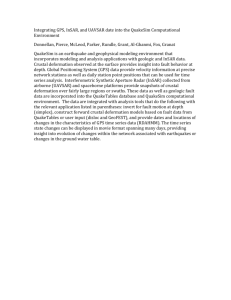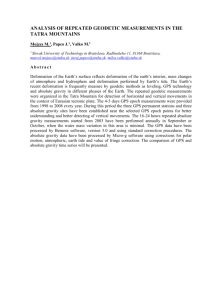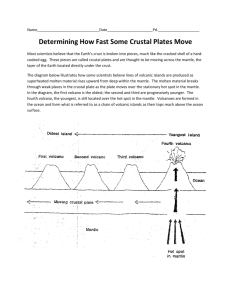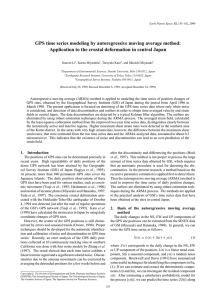Research Report
advertisement
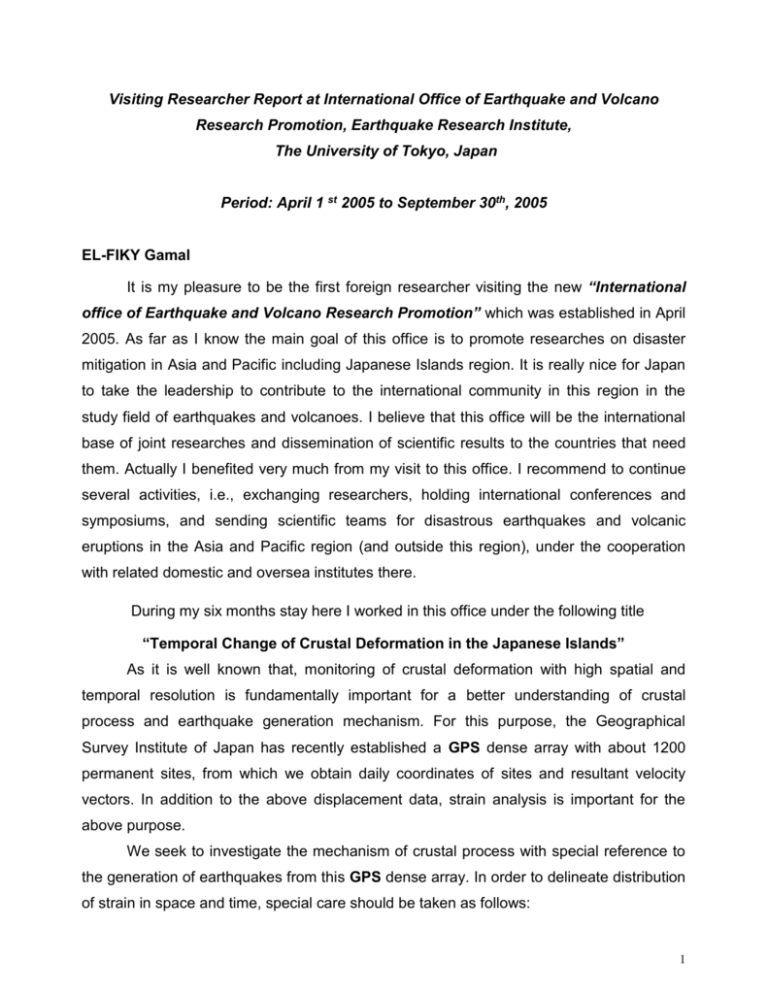
Visiting Researcher Report at International Office of Earthquake and Volcano Research Promotion, Earthquake Research Institute, The University of Tokyo, Japan Period: April 1 st 2005 to September 30th, 2005 EL-FIKY Gamal It is my pleasure to be the first foreign researcher visiting the new “International office of Earthquake and Volcano Research Promotion” which was established in April 2005. As far as I know the main goal of this office is to promote researches on disaster mitigation in Asia and Pacific including Japanese Islands region. It is really nice for Japan to take the leadership to contribute to the international community in this region in the study field of earthquakes and volcanoes. I believe that this office will be the international base of joint researches and dissemination of scientific results to the countries that need them. Actually I benefited very much from my visit to this office. I recommend to continue several activities, i.e., exchanging researchers, holding international conferences and symposiums, and sending scientific teams for disastrous earthquakes and volcanic eruptions in the Asia and Pacific region (and outside this region), under the cooperation with related domestic and oversea institutes there. During my six months stay here I worked in this office under the following title “Temporal Change of Crustal Deformation in the Japanese Islands” As it is well known that, monitoring of crustal deformation with high spatial and temporal resolution is fundamentally important for a better understanding of crustal process and earthquake generation mechanism. For this purpose, the Geographical Survey Institute of Japan has recently established a GPS dense array with about 1200 permanent sites, from which we obtain daily coordinates of sites and resultant velocity vectors. In addition to the above displacement data, strain analysis is important for the above purpose. We seek to investigate the mechanism of crustal process with special reference to the generation of earthquakes from this GPS dense array. In order to delineate distribution of strain in space and time, special care should be taken as follows: 1 1- Since the GPS data is somewhat noisy especially for short time intervals of observations, we need to use a technique to separate the signal from noise with the data for high temporal resolution. 2- Although the strain analysis of the conventional “triangulation” net naturally assumes uniform strain within each geodetic triangle, GPS array allows us to treat the crust as continuous media, so that we need to consider continuous presentation of strain in space. I have introduced, in my doctoral thesis and some researches, the Least-Squares Prediction (LSP) technique to delineate crustal strains from geodetic data (e.g., El-Fiky et al., 1997; El-Fiky and Kato, 1999, El-Fiky 2000, the details of these references are available with Prof. Kato). This technique seems most adequate to apply to GPS dense array data because it can separate signal from noise very efficiently. Also, it can provide us with continuous representation of strain patterns in the Japanese Islands. During my stay here as visiting researcher, I applied the above technique to GPS dense array data in the Japanese Islands for the period from April 1st, 1996 to February, 24th, 2001 to study the crustal deformation. I first model each time series of the GPS components as a linear combination of linear function, trigonometric function, and jumps for episodic events. Estimated velocities after fitting converted into a kinematic reference frame (Heki, 1996) to discuss the crustal deformation relative to the stable interior of the Eurasian plate. I used Least-Squares Prediction technique to segregate the signal and noise in horizontal as well as vertical velocity. Then, estimated horizontal signals (horizontal displacement rates) has been differentiated in space to calculate principal components of strains. Obtained strains seem to portray tectonic environments of the Japanese Islands; (1) dilatational strains show that the Japanese Islands are under the compressive strain regime induced by the subducting Pacific and Philippine Sea plates, (2) maximum shear strains show a good agreement with recent crustal activities, and (3) principal axes of the strains indicate that the Japanese Islands are under the influence from the converging oceanic plates. On the other hand, the secular vertical deformation field of the Japanese Islands has been derived for the same of GPS data interval. I combined the GPS vertical velocities with 31 year tide gage data to obtained absolute vertical velocity. The estimated pattern of vertical velocity shows that (1) a clear uplift pattern of about 6 mm/yr in the Shikoku district 2 and Kii Peninsula, whereas subsidence pattern is seen in the coast of Kyushu district. This is consistent with the strong coupling between the Philippine Sea plate and overriding plate at the Nankai Trough and weak coupling off Kyushu, (2) no clear uplift pattern is seen along the Pacific coast of northeastern part of Japan. This might be due to the plate boundary is too far seaward from the GPS sites or might be due to weak coupling there, (3) significant uplift pattern is observed in the southwestern Hokkaido and in northeastern Japan along the Japan Sea coast of Tohoku district, which might be due to the long-term postseismic rebound of the 1983 Japan Sea (M7.7) and the 1993 Hokkaido-Nansei-oki (M = 7.8) earthquakes and/or associated with the convergence plate of incipient subduction there. Finally, I investigate the origin of the present GPS deformation in the Japanese Islands by comparing velocity fields determined from GPS data with those calculated from the elastic dislocation models involving interplate motion at the subduction zones in southwestern and northeastern Japan. Since horizontal data does not permit the separation of rigid plate motion and interplate coupling because horizontal velocities include both effects, I used the vertical velocities to discriminate between them. I then showed that most of this GPS velocity field can indeed be accounted for by full elastic coupling along Philippine locked thrust zone where it is only 50% coupling for the Pacific locked zone. The main results of the above study are submitted for publication to the Journal of Tectonophsics (El-Fiky, G. S., and T. Kato, submitted to the J. of Tectonophsics, Sep. 21st, 2005) Acknowledgment I am greatly indebted to Prof. Teruyuki Kato, my host and the director of International Office of Earthquake and Volcano Research Promotion for his generous support of this work. Fruitful discussions with him were very helpful and greatly appreciated. My thanks also extended to Ms. Tokie Watanabe, the manager of the office, for her kind help and support during my stay. 3

